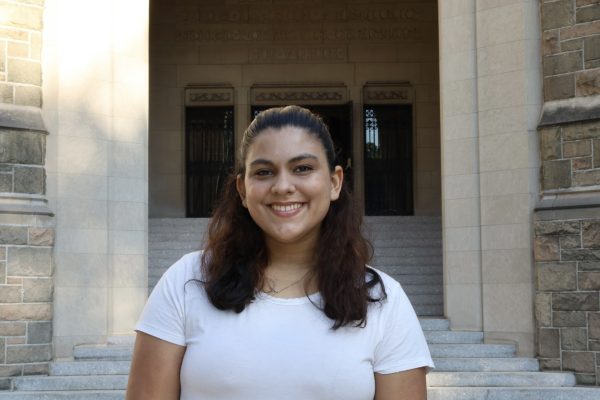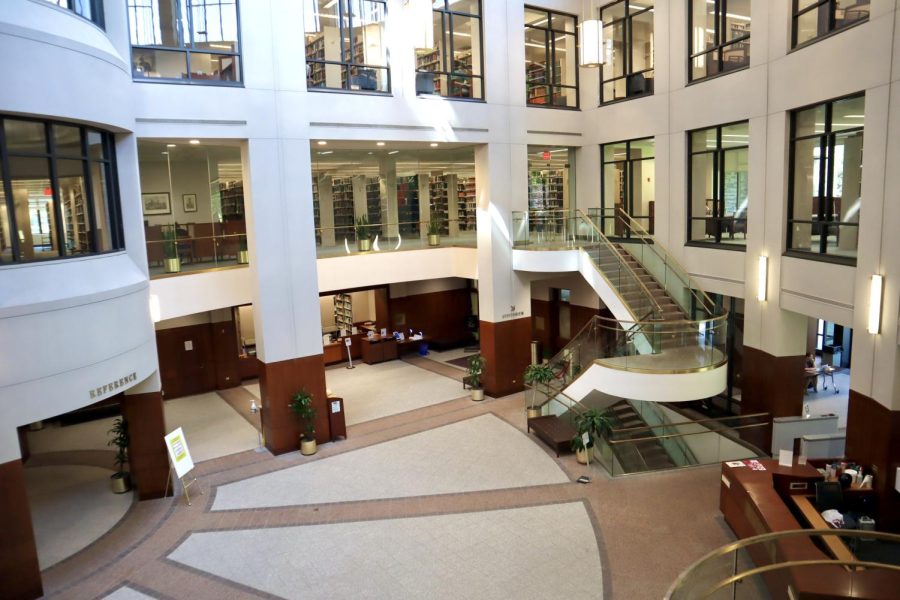Walsh Library Turns 25
Rose Hill’s William D. Walsh Family Library celebrated its 25th birthday this year. The library opened on May 27, 1997, for the summer session courses, as reported by Courtney McGrath in The Fordham Ram archives. It replaced the Rose Hill campus’ previous academic library, the Duane Library, which has served as an administrative building since. Walsh Library was built with numerous features, such as a surplus of computers, multiple copy centers, 20 group study rooms and a small auditorium to accommodate the critiques that students and faculty had about the lack of resources in the previous Duane Library.
The construction of the Walsh Library was a $54 million endeavor. It was paid for by a mix of government grants, money raised by alumni and other contributors. $10.5 million of this fundraising came from Fordham alumnus William D. Walsh, who the library is named after. Walsh was a successful businessman in California who attributed his accomplishments to his Jesuit education and looked to give back to both Fordham and the wider New York City community. The project first began construction in 1994 but faced multiple delays including harsh winter weather impeding progress, as well as time-consuming wiring and import demands to build the library as it was desired to be.
Since its completion in 1997, Walsh Library has endured a great deal, including the flooding damages in early September of last year. However, it has continued to be a staple of campus life for many. This May marked the 25th anniversary of the library’s opening and it is a triumph which the library department has planned to celebrate with the Fordham community.
Fordham Library News published an article stating that the library would honor this anniversary with the launch of the Walsh25 campaign. They have planned numerous celebrations to take place throughout the fall semester. During the first week of classes, students who visited the library likely noticed the display of free Walsh Library merchandise. The opportunity to grab some of the items is not gone forever, as the library plans to sporadically set up some more giveaways.
Additionally, the Exhibition Hall located on the first floor of Walsh is currently home to a display about the history of the library. It contains a collection of writings, designs, blueprints and modeling from when the building was undergoing its original construction. Current students and community members can get a snapshot of the library’s construction process, opening and history. As of early September, there were plans to add a display of books which were best sellers in 1997, when the library doors opened. The display will remain in place through October.
Fordham University Director of Libraries Linda LoSchiavo was able to provide her insight into both the history and the future of Walsh Library. LoSchiavo explained that the library was designed by Shepley Bulfinch, a prominent architecture firm for academic libraries, just at the start of the more technological era. Because of this, the library has needed to change throughout its 25 years to keep pace with electronic advancements. However, Walsh Library is flexible, keeping its traditional aspects throughout these transitions.
LoSchiavo detailed some of the functional transitions that various areas of the library have undergone, including what was once the Periodicals Reading Room being converted into the Fordham Museum of Greek, Etruscan and Roman Art.
What current students know as the East Reading Room was once the Reserve Room, among other changes. However, LoShiavo highlights an important consistency of the Walsh Library as well. That is the large volume of physical books that the library is home to. Despite the increasing prevalence of e-books and other online resources, especially since the start of the COVID-19 pandemic, Walsh Library continues to grow its collection of over one million books.
In terms of the biggest change in student use of the library, LoSchiavo explains that as the emphasis on collaborative work has become more common, so has the occurrence of seeing multiple students occupying the study rooms at a time. However, according to LoSchiavo, some student habits don’t seem to ever change.
“One of the things that hasn’t changed is that students are still trying to sneak food into the library but our detection rate is very high,” said LoSchiavo.
The story of the Walsh Library is far from over.
“Walsh Library has a long life ahead of it. Every university library has a core set of deliverables that will never change. Students and faculty want and need information,” said LoSchiavo. “They want places to study, to read, to do research, to collaborate with each other. They need librarians to guide them through some of this and to make sure that research and teaching needs are supported. None of this has changed in the past 25 years, nor will it in the next 25.”
LoSchiavo said that the role of the library staff is likely to change drastically, as will the technology once again, but books will remain on the shelves. Beyond that, she said it is hard to predict what the future will hold.
For updates on the Walsh25 celebratory events and other library events, one can refer to the University Libraries’ social media pages.
They are accessible on Twitter, Instagram and Facebook in addition to the library website.

Julianna Morales is a senior from Pittsford, N.Y., majoring in psychology with a double minor in English and disability studies. Julianna joined the Ram...







































































































































































































